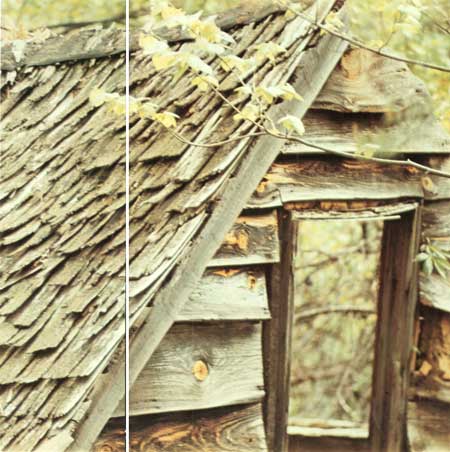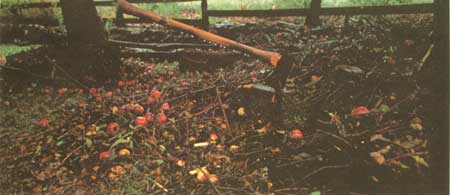|
SHENANDOAH National Park |
 |
Man Lives on the Mountain
On March 18, 1669, John Lederer left his horse with an Indian guide somewhere at the eastern foot of the Blue Ridge and climbed to the top of a high mountain. "Here did I wander in Snow, for the most part, till the Four and twentieth of March, hoping to finde some passage through the Mountains ...", he wrote. But he became discouraged, and returned eastward. Since he left a written account of his explorations, Lederer now gets credit for being the park area's first non-Indian visitor.
What sort of landscape did Lederer see during his ridgetop wanderings? He tells us little, but probably it was not much different from today's, though with more impressive forest on the lower slopes, and perhaps more openings on slopes and ridges, made by fires. Game certainly abounded. He saw deer, and "on the hillsides, Bear crashing Mast like Swine." Bison, elk, wolves—all now gone—he could have seen. The Indians were leaving a rich estate.
 Remains of some mountain homes, like this one at Nicholson Hollow, can still be seen in the park. (Photo by Russ Nicholson) |
When President Franklin Roosevelt, on July 3, 1936, ascended the Blue Ridge and drove to Big Meadows (on the partly completed Skyline Drive) to dedicate Shenandoah National Park, he saw a still beautiful but a poorer landscape. In the more rugged hollows, deep forest with many big trees remained; but most of the slopes bore half-grown trees, the valuable timber long-gone to sawmills, and many open fields remained on mountaintops, gentle slopes, and flat-floored hollows. Between Lederer and Roosevelt, many men had climbed the mountains, lived here, and left their mark.
The flow of settlement, which followed explorers, trappers and traders, moved simultaneously westward across Virginia into the eastern foothills of the Blue Ridge and southward from Pennsylvania into the Shenandoah Valley, reaching both areas around 1730. The first land taken was probably that already opened up by Indians, grazing animals, and beaver activities. Occupation of the mountain hollows probably came later, since most of these would have required clearing before crops could be raised. Taking first the more fertile and level land at the mouths of hollows, settlement (mostly by Scotch-Irish, Irish, English, and Germans) then usually proceeded up-hollow, until the narrowing, steep-sided stream valleys forced a halt. These early mountain folk found nature generous. Once they had cleared some land, using the Indian method of killing trees by girdling and then burning, the fertile soil gave them good crops of corn, beans, squash, cabbage, and tobacco, as well as grass for their livestock. The forest gave them game, chestnuts, walnuts, berries, and wild honey for the table, furs for clothing and trade, and wood for cabins, fences and fireplaces. Springs and streams provided water. The sheltering slopes protected them from the worst of winter weather.
Later arrivals had less productive land to choose from, and many opted for gap or ridgetop locations, where slopes were gentle but weather rough. As roads were built through the gaps, some people became toll-takers here. In such places one could graze cattle, plant fruit trees, and scratch out garden patches—as most mountain families did. Nearly always there was a spring just below the gap. The prevailing westerly winds which often howl through these dips in the ridge made an east-side homesite more comfortable than a west-side one.
Ridgetop sites were perhaps the most difficult. Good grazing could be established in these places, and many people kept the livestock of valley-dwellers as well as their own here in summer. Crops could be raised on the more level land, such as Big Meadows. But the climate was tough—subzero winds and deep-piled snow were not what the pioneer from the Virginia lowlands or ocean-moderated Europe was used to. Water usually had to be carried uphill. Settlement on the ridgetops hinted that a land pinch was beginning.
Around the middle of the 19th century, the forests began to mean money in the pocket as well as direct supplies for the family. A market for lumber (mainly oak, chestnut, yellow-poplar, and pine) brought small sawmills to the heads of hollows, to which many a mountain farmer mule-dragged trees cut from his land. About the same time, a market for tanbark also developed. (The bark of chestnut oak and hemlock, and both bark and wood of chestnut, were used in the tanning of hides. The tannery at Luray used chestnut oak bark until 1952.) The trees were cut in spring and early summer when sap was running; the bark was peeled, and the logs generally were left. Some of the old roads in the park, whose traces can still be seen, were built to sled tanbark and haul logs.

The highwater mark of lumbering in the Blue Ridge came in the two decades after the Civil War. A great local demand for lumber, created by Gen. Philip Sheridan's scorched-earth practices in the Shenandoah Valley during the war, and a more distant demand, served by a growing rail network and large timber companies, decimated the remaining stands of virgin trees. Only the stunted, ice- and wind-pruned trees on ridgetops and the big but inaccessible trees in steep, rocky hollows escaped cutting. By the 1920's, even such precipitous places as Whiteoak Canyon were being eyed. The few giants we see today were saved by the roughest of topography or by human protection. George Freeman Pollock—who built Skyland and avidly promoted establishment of a park—steadfastly refused to allow lumbering on his land, thus preserving many magnificent trees in such places as Whiteoak Canyon and Cedar Run.
Human impact on the Blue Ridge probably reached its zenith about 1900. By then, virtually every piece of land that would produce anything was occupied, and pastures and gardens had replaced as much of the former forestland as they ever would. But by then, living on these mountains had for many become a marginal existence. The soil was losing its fertility from too little rest and rotation; in some places it was washing away. Along with the depleted condition of soil and forests went a depleted supply of game—particularly the larger animals, such as deer, bear, and turkey, which were all either gone or extremely scarce. Reduction of forests had no doubt contributed to the disappearance of bears and turkeys, which require extensive woodlands, and year-round hunting had pressured all three.
The mountain people were pinched not only by the land they had oversettled, but by the economy of rural America. More and more, living required cash, and there weren't many sources of that in the hollows. As the century moved on, lumber and fur markets deteriorated, and the chestnut blight began wiping out that food-and-money tree.
So the exodus began. Between 1900 and 1925 perhaps half of the residents left the park area. With their departure, the forest began its return—a slow but continuous process that was further encouraged by the establishment of Shenandoah National Park in 1935, when the remaining families were required to leave and a new way of using the land began.
Today the ring of axes is heard only in campgrounds, and the tinkle of cowbells nowhere, but under the ever-deepening green canopy lie everywhere the signs of an earlier life. Fallen stone walls, rotting chestnut rails, and rusting barbed wire snake through the forest under blankets of creeping vegetation. Old roads, now hardly discernible, wind down ridges and hollows. And rectangular foundations, slow to allow plant growth, show us where our predecessors chose to live. Apple trees, young pines and locusts, and stands of fast-growing yellow poplars mark former orchards and pastures.
Looking at these traces of mountain life, one cannot help wondering what it was like. Was it a good life—independent, fruitful, inspirited by the high blue horizons? Or was it a spiritless struggle for survival? I suppose it was both—for mountain people, like those in any community, were varied in talents and fortune as well as in resources. Talk to Ranger Roy Sullivan, who as a boy in Simmons Gap sometimes shot 30 rabbits in a day and sold them to the local storekeeper at 25 cents apiece, or to District Ranger Bob Johnson, whose family made a good living on Piney Branch of the Thornton River; you will come away with a certain nostalgia for the good old days. But read Hollow Folk, a sociological study of life around 1930 in hollows near Old Rag, and you are depressed by the semi-human state that isolation and poverty had produced here.
Men live in mountains the world over, but few societies have been able to inhabit them densely without gradually destroying their soil. In the Blue Ridge, the land was good to the people, as long as they were good to it, but in the end there was too much abuse, and the land rebelled.

|

|
| NPS History | History & Culture | National Park Service | Contact |
|
Last Modified: Sat, Nov 4 2006 10:00:00 pm PST |


